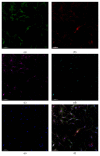Immature Vascular Smooth Muscle Cells in Healthy Murine Arteries and Atherosclerotic Plaques: Localization and Activity
- PMID: 35163667
- PMCID: PMC8835789
- DOI: 10.3390/ijms23031744
Immature Vascular Smooth Muscle Cells in Healthy Murine Arteries and Atherosclerotic Plaques: Localization and Activity
Abstract
The local development of atherosclerotic lesions may, at least partly, be associated with the specific cellular composition of atherosclerosis-prone regions. Previously, it was demonstrated that a small population of immature vascular smooth muscle cells (VSMCs) expressing both CD146 and neuron-glial antigen 2 is postnatally sustained in atherosclerosis-prone sites. We supposed that these cells may be involved in atherogenesis and can continuously respond to angiotensin II, which is an atherogenic factor. Using immunohistochemistry, flow cytometry, wound migration assay xCELLigence system, and calcium imaging, we studied the functional activities of immature VSMCs in vitro and in vivo. According to our data, these cells do not express nestin, CD105, and the leptin receptor. They are localized in atherosclerosis-prone regions, and their number increases with age, from 5.7% to 23%. Immature VSMCs do not migrate to low shear stress areas and atherosclerotic lesions. They also do not have any unique response to angiotensin II. Thus, despite the localization of immature VSMCs and the presence of the link between their number and age, our study did not support the hypothesis that immature VSMCs are directly involved in the formation of atherosclerotic lesions. Additional lineage tracing studies can clarify the fate of these cells during atherogenesis.
Keywords: CD146; NG2; angiotensin II; angiotensin II receptor type 2; atherosclerosis; immature smooth muscle cells; pericytes.
Conflict of interest statement
The authors declare no conflict of interest.
Figures



















Similar articles
-
Potential role of insulin receptor isoforms and IGF receptors in plaque instability of human and experimental atherosclerosis.Cardiovasc Diabetol. 2018 Feb 20;17(1):31. doi: 10.1186/s12933-018-0675-2. Cardiovasc Diabetol. 2018. PMID: 29463262 Free PMC article.
-
Genetic Evidence Supports a Major Role for Akt1 in VSMCs During Atherogenesis.Circ Res. 2015 May 22;116(11):1744-52. doi: 10.1161/CIRCRESAHA.116.305895. Epub 2015 Apr 13. Circ Res. 2015. PMID: 25868464 Free PMC article.
-
Deletion of angiotensin-converting enzyme 2 promotes the development of atherosclerosis and arterial neointima formation.Cardiovasc Res. 2014 Feb 1;101(2):236-46. doi: 10.1093/cvr/cvt245. Epub 2013 Nov 4. Cardiovasc Res. 2014. PMID: 24193738
-
The role of smooth muscle cells in plaque stability: Therapeutic targeting potential.Br J Pharmacol. 2019 Oct;176(19):3741-3753. doi: 10.1111/bph.14779. Epub 2019 Aug 9. Br J Pharmacol. 2019. PMID: 31254285 Free PMC article. Review.
-
Autophagy: a killer or guardian of vascular smooth muscle cells.J Drug Target. 2020 Jun;28(5):449-455. doi: 10.1080/1061186X.2019.1705312. Epub 2020 Feb 5. J Drug Target. 2020. PMID: 31835918 Review.
References
-
- Steffensen L.B., Mortensen M.B., Kjolby M., Hagensen M.K., Oxvig C., Bentzon J.F. Disturbed Laminar Blood Flow Vastly Augments Lipoprotein Retention in the Artery Wall: A Key Mechanism Distinguishing Susceptible from Resistant Sites. Arterioscler. Thromb. Vasc. Biol. 2015;35:1928–1935. doi: 10.1161/ATVBAHA.115.305874. - DOI - PubMed
-
- Andrés V., Dorado B. Methods in Mouse Atherosclerosis. Volume 1339 Springer; New York, NY, USA: 2015.
-
- Langhaas T. Beiträge zur normalen und pathologischen Anatomie der Arterien. Arch. Pathol. Anat. Physiol. Klin. Med. 1866;36:187–226. doi: 10.1007/BF01927642. - DOI
MeSH terms
Substances
Grants and funding
LinkOut - more resources
Full Text Sources
Molecular Biology Databases

